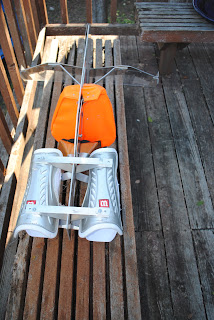Yesterday I joined Hackerspace ATX and worked on the 7th prototype of the Merfluke. The main difference between this and the Mark 6 is improved pedals. Today at 11:30 I went to the Hackerspace but nobody was there---I need to become an associate member so I can get in.
Nonetheless, today I completed the new pedals and reassembled the Merfluke Mk 7. This weekend I will give it another test run, probably in Lake Pflugerville on Saturday afternoon. If there are no major problems I will try to time myself swimming a few hundred meters, and perhaps I can get my wife or some volunteer to video tape me swimming---I would love to be able to analyze my technique, since it is entirely possible small changes could make a big difference. I doubt the water is clear enough to show much, but anything is better than nothing.
I am reasonably confident, based on prior experience, that the Mark 7 will be better than the Mark 6, but probably will not approach the speed with which I can monofin.. I hope at least I can acheive the speed at which I can swim freestyle unaided.
Here are some photos of the Mark 7.
This is a side-on view---my body would be to the left, with my shins embraced by the white soccer shin guards and my feet on the ugly orange pedals, which are more hydrodynamic and lighter than my last ones.
Here is sort of a pedal detail:
Looking down, showing the fluke as well as the pedals:
A detail of the fluke, which is Polycarbonate riveted to aluminum, with side rails.
A view of the wood block that sits on the top of my left foot, allowing me angle the fluke upward by pulling with my feet. The asymmetry the foot pull power and push power is a major unsolved problem. I would like to figure out a way to add a spring that equalizes it somewhat, but I don't know how to do it hydrodynamically.
A view looking down, with my feet for scale.
The braces that hold my legs. Very un-streamlined. They do have to be sturdy, however, because most of the up-and-down power which provides propulsion is borne by the shin-guards and transmitted to the frame through those braces.








Robert -- This is splendid! A blog for all your creativity and inventions and networking for a higher purpose. You are so ambitious and clever.
ReplyDeleteOf course you know that you sent me your first issue of The Public Inventor, which I took with me while traveling over the holidays and read with fascination, but please forgive me for not getting back to you before now about it. As a wordy person who is painfully out of her depth on anything resembling engineering or physics, I only wish I could comment intelligently on the Ten Project Ideas in it. But what I can do is gladly point out any helpful resource I may come across in my reading and research. Being a history nerd, I'm constantly surprised at some of the brilliant ideas and inventions that were engineered long ago and have almost been forgotten. Maybe there's the germ of a modern invention in one of them?
As for your Merfluke - after reading about it in your story I love seeing photos of the prototype. It looks nothing like the usual fins, obviously. Would studying fast-moving sea animals other than fish help, such as the octopus? I'm really not sure. In the meantime, please don't drown while testing it.
The policies and philosophy of PIFAM are admirable and very American. It reminds me of the Shakers, who invented several handy everyday tools but refused to patent them in the belief that what they created belonged to all mankind.
I plan to be, at the very least, a follower and cheerleader of PIFAM. Maybe I'll even smart up and contribute some ideas.
Bravo, Robert.
Thanks, Helena. Y'all should check out Helena's blog, "Becoming Layla".
ReplyDeleteOctopuses move by generating a wave in the stretchy flesh between their tentacles. A human being could use a membrane stretched between the limbs---sort of a moist flying squirrel approach. It might be lovely to see such a wave pattern propelling a human, but I doubt it would be very fast. For the time being, I'm sticking to dolphin-like propulsion until I succeed or fail finally.
BTW, squids use jet propulsion. I think it would be interesting, but a totally different approach, but try to build a bag that a human could some how "jump" onto with the legs underwater, producing a propulsive squirt of water.
I certainly hope that PIFAM is considered very "American". I am strongly inspired by Richard Stallman and the free software movement, which are sometimes accused of being leftist and un-American, but I think that is hogwash---I can't imagine anyone more American than Benjamin Franklin, Buckminster Fuller, or Richard Stallman, and I'm just trying to move in the same direction that they pioneered.